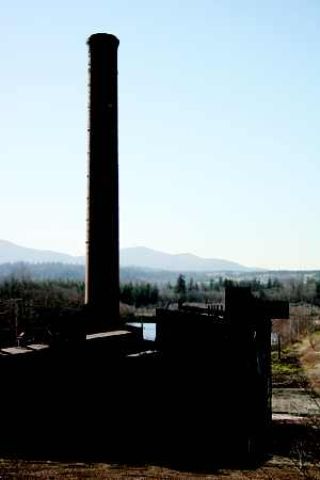SNOQUALMIE – The only thing standing in the way of the rest of the historic Weyerhaeuser mill becoming a pile of rubble is the Snoqualmie Valley Historical Society.
On March 3, the society will make its case to the King County Landmarks Commission that what is left standing of the mill should be preserved as a county landmark. The decrepit powerhouse and brick stack were set to come down with the rest of the mill last year, but moves by the historical society put the demolition off until the county could consider the building as a historical landmark.
“For some people in the Valley, three or more generations went through that mill,” said Dave Battey, secretary of the Snoqualmie Valley Historical Society. “There should be some memorial to that in the Valley.”
Past employees of the mill and Valley historians alike said what’s left of the mill symbolizes what was the crux of the Valley’s existence for many years during the last century. Construction on the mill started in 1916 and it grew to an industrial community that covered 600 acres, including the now defunct town of Snoqualmie Falls. Many Valley residents have memories of that town’s YMCA community hall, school, hospital and neighborhoods that surrounded the mill, and just about everyone knows someone who worked for Weyerhaeuser.
Ward Keller, whose father Harold ran the YMCA in Snoqualmie Falls and became the official photographer for Weyerhaeuser, said his father’s pictures show just how much a part of the social and economic life the mill was in the area. There were hundreds of events every year at the community center, and the town’s hospital had 50 beds. Life was so tied to the mill that its power plant supplied the electricity to the town’s households, and when one of the mill’s large saws hit a snag, all the lights in town would dim.
“It has a great history,” Keller said.
Built just one year after the mill opened, the historic powerhouse and brick stack have seen more history pass through its doors than any other building at the mill site. Outside of some modifications made throughout the years, the two structures remain true to their original shapes and helped make up the closest thing to a “skyline” the Valley ever had.
Snoqualmie resident Bob Hamerly went to work in the powerhouse in 1939 at the age of 18 and stayed on at Weyerhaeuser, eventually becoming manager of the powerhouse, until he retired in 1980. He remembered the different technologies that came through the powerhouse as more voltage was needed to power the growing operation.
“For years, it kept the Valley going,” he said.
The timber industry started to wane, however, and the first mill was closed in 1989. Planing, drying, grading and shipping work remained at the site, but all of those jobs eventually dwindled away as well. In 2002, the Snoqualmie Tree Farm was sold and Weyerhaeuser stopped all work at the site the following year. The structures at the site have been systematically disabled, with the younger of the two smoke stacks (built in 1944) coming down last year.
“It was kind of sad,” said Hamerly, who got to ignite the charge that brought down the stack.
That was when the county became involved, according to Julie Koler, a historic preservation officer for King County’s Historic Preservation Program. Her office was contacted by the historical society last year about saving the powerhouse and older stack and the process was put in motion to get a hearing for the society.
Koler said the public will get to make cases for or against preserving the buildings at a commission’s meeting this week and that a decision could come as early as that night.
Even if the stacks are preserved, Koler said they may not be preserved indefinitely. After their properties are designated as historical landmarks, landowners can appeal to the county for a permit to make changes to the building if they can prove it would be too burdensome and/or hazardous to maintain. The structure is crumbling and keeping the area safe would be a challenge.
Weyerhaeuser spokesman Frank Mendizabal said the company has not yet decided wants to do with the mill site.
Keller said that at its peak, the mill had an economic tie to 80 percent of the Valley. Now, he said, 80 percent of the Valley has no idea how important the mill was to the area. He is hoping the county can prevent that history from eroding any further.
* The King County Landmarks Commission will take place at 7 p.m. Thursday, March 3, at Si View Community Center, 400 S.E. Orchard Dr., North Bend. The public hearing regarding the power house and brick stack is expected to start at 8 p.m.


